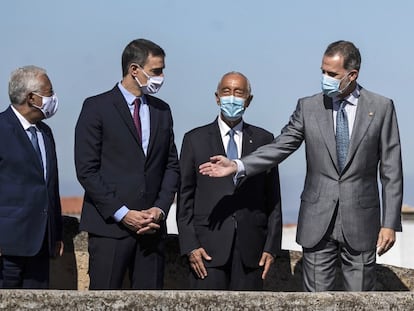No international visitors and zero spending: Spain records another dismal month for tourism in May
The coronavirus crisis continues to take a toll on the industry, which faces an increasingly uncertain future despite the reopening of borders

The impact of the coronavirus crisis on Spain’s ailing tourism industry continues to deepen, with new figures confirming one of the worst forecasts for the sector. For a second month in a row, Spain received no international visitors and recorded zero spending in May, according to new figures published Thursday by the country’s National Statistics Institute (INE).
In mid-March, the Spanish government declared a state of alarm in a bid to curb the spread of the coronavirus. These emergency powers allowed the government to introduce strict confinement measures and restrictions on travel. That month, after being under the state of alarm for just two weeks, the number of international visitors in Spain fell 64% and spending by 63%.
Overnight stays in hotels fell 99.9% in May, compared to the same month in 2019
This drop was also due to the travel bans introduced across the world and the closure of borders. Although the fall was expected it was no less traumatic for an industry that accounts for 12% of Spain’s gross domestic product (GDP), and that continues to face an uncertain future, despite the partial reopening of European borders over the last few weeks.
The accumulated losses sustained by the industry this year have placed tourism businesses under enormous strain, a strain that is also being felt by the Spanish economy. In the first five months of the year, 10.5 million tourists arrived in Spain and spent €11.7 billion – a fall of 64% and 62%, respectively, against the same period in 2019. Companies in the industry have warned that they are at breaking point due to the lack of liquidity. There is an increasingly real threat that part of Spain’s productive framework could fall apart. And time is running out for the industry to bounce back. Just in the month of May 2019, nearly eight million tourists arrived in Spain and spent close to €8.2 billion. In the lead-up to summer, the industry typically warms up and begins to see a rise in visitors and tourist spending. But not this year.
“There are some exceptions regarding the flow of people who can cross the Spanish border, for instance Spanish citizens who are residents in other countries and were allowed to enter Spanish territory after the [state of alarm] orders came into effect, as well as other visitors with a justified reason [for entering the country], who could in some cases be considered visitors,” explained the INE report. “However, the reduced volume of this flow and impossibility of accrediting their character (it is difficult to know whether the reason for their trip was tourism) advises against them being counted as such.” The report concluded: “During the month of May, the number of international visitors to Spain for tourism reasons across all means of entry was zero.”
Many large hotel chains and restaurants in Spain remain closed even though travel within the EU is permitted
A few days ago, the INE also released figures on hotel stays during the month of May. In this case, as with international tourist arrivals, occupancy plummeted. Although hotels were allowed to open from May 11, when parts of Spain entered Phase 1 of the coronavirus deescalation plan, only 4.3% of the total number of spaces were on offer. Overnight stays in hotels also fell 99.9% compared to the figures from May of last year.
The data from the INE has once again confirmed that the border closures have caused this collapse. In the case of hotels, the fall in occupancy was due to the fall in international visitors, as well as the mobility restrictions within Spain. These problems have brought the hotel sector to a standstill, and the outlook for June is not much better, given that countries within the European Union and Schengen Area only began to open their borders on June 21. Businesses in the sector are preparing for the summer high season, but there is still a lot of uncertainty about whether there will be enough demand. Faced with these doubts, many large hotel chains and restaurants remain closed even though travel within the EU is permitted.
English version by Melissa Kitson.
Tu suscripción se está usando en otro dispositivo
¿Quieres añadir otro usuario a tu suscripción?
Si continúas leyendo en este dispositivo, no se podrá leer en el otro.
FlechaTu suscripción se está usando en otro dispositivo y solo puedes acceder a EL PAÍS desde un dispositivo a la vez.
Si quieres compartir tu cuenta, cambia tu suscripción a la modalidad Premium, así podrás añadir otro usuario. Cada uno accederá con su propia cuenta de email, lo que os permitirá personalizar vuestra experiencia en EL PAÍS.
¿Tienes una suscripción de empresa? Accede aquí para contratar más cuentas.
En el caso de no saber quién está usando tu cuenta, te recomendamos cambiar tu contraseña aquí.
Si decides continuar compartiendo tu cuenta, este mensaje se mostrará en tu dispositivo y en el de la otra persona que está usando tu cuenta de forma indefinida, afectando a tu experiencia de lectura. Puedes consultar aquí los términos y condiciones de la suscripción digital.
More information
Últimas noticias
Most viewed
- Sinaloa Cartel war is taking its toll on Los Chapitos
- Oona Chaplin: ‘I told James Cameron that I was living in a treehouse and starting a permaculture project with a friend’
- Reinhard Genzel, Nobel laureate in physics: ‘One-minute videos will never give you the truth’
- Why the price of coffee has skyrocketed: from Brazilian plantations to specialty coffee houses
- Silver prices are going crazy: This is what’s fueling the rally










































